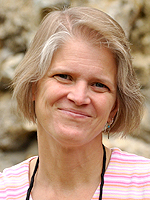Cynthia C. Bennington
Professor of Biology
Cindy Bennington has conducted ecological research in Alaska, West Virginia, New Jersey and Florida. At Stetson, she teaches ecological and botanical courses and actively engages students in research on the ecology of Florida native plants, particularly those found in upland longleaf pine habitats.
- Postdoctoral Associate, Princeton University, 1994-1996
- PhD, West Virginia University, 1994
- MS, West Virginia University, 1990
- BS, West Virginia University, 1984

Biography
Cindy Bennington has conducted ecological research in Alaska, West Virginia, New Jersey and Florida. At Stetson, she teaches ecological and botanical courses, actively engaging students in research on the ecology of Florida native plants. As a co-creator and co-manager of the Volusia Sandhill Ecosystem adjacent to the Gillespie Museum, she is an active proponent for the conservation of small urban habitat fragments that reflect a site's historic natural history. In particular, her research addresses questions related to the conservation and management of Florida sandhill habitat and her teaching engages undergraduates in management and educational outreach related to this declining ecosystem.
More About Cynthia C. Bennington
Areas of Expertise
- Plant evolutionary ecology
- Sandhill ecosystems
Course Sampling
- Ecology and Evolution
- Flora of Florida
- Plant Ecology
- Environmental Biology
- Pollinator communities in urban habitat fragments
- Restoration of sandhill habitat
- Mycorrhizal fungi in habitat restoration
- Smart-Marshall, G., C. Haines, J. Smith, and C. Bennington. Submitted. Arbuscular mycorrhizal fungi form associations with understory plant species in Florida sandhills. Submitted to The Southeastern Naturalist
- Bennington, C. and P. May. 2020. Pollinator communities of restored sandhills: a comparison of insect visitation rates to generalist and specialist flowering plants in sandhill ecosystems of central Florida. Natural Areas Journal 40(2):168-178Bennington, C. and K. Cole. 2017 (co-editors). The Outdoor Classroom. The Southeastern Naturalist.16(Special issue 10).
- Cole, K. and C. Bennington. 2017. From the ground up: Natural history education in an urban campus restoration. The Southeastern Naturalist. 16(Special issue 10):132-145.
- McGraw, J., J Turner, S. Souther, C. Bennington, M. Vavrek, G. Shaver, and N. Fetcher. 2015. Northward displacement of optimal climate conditions for ecotypes of Eriophorum vaginatum L. across a latitudinal gradient in Alaska. Global Change Biology. 21: 3827-3835.
- Chandler, J. L., J. B. McGraw, C. C. Bennington, G. R. Shaver, M. C. Vavrek, and N. Fetcher. 2014. Tiller population dynamics of reciprocally-transplanted Eriophorum vaginatum L. ecotypes in a changing climate. Population Ecology (published online)
- Matthews, C., T. Marchbanks, and C. C. Bennington. 2014. Inducibility and trade-offs in defense traits of a common perennial vine (Passiflora incarnata). Florida Scientist 77(2): 98-108.
- Bennington, C. C., N. Fetcher, M. C. Vavrek, G. R. Shaver, K. Cummings and J. B. McGraw. 2012. Home site advantage in two long-lived arctic plant species: Results from two thirty-year reciprocal transplant studies. Journal of Ecology 100: 841-851.
- Peterson, C. A., N. Fetcher, J. B. McGraw, and C. C. Bennington. 2012. Clinal variation in stomatal characteristics of an Arctic sedge, Eriophorum vaginatum L. (Cyperaceae). American Journal of Botany 99:1-10.
- Konstantinidis, N., J. Duffy, and C. C. Bennington. 2010. Biological defense in Passiflora incarnata: Evidence for a chemical defense against ant defenders. Florida Scientist. 73:1-9.